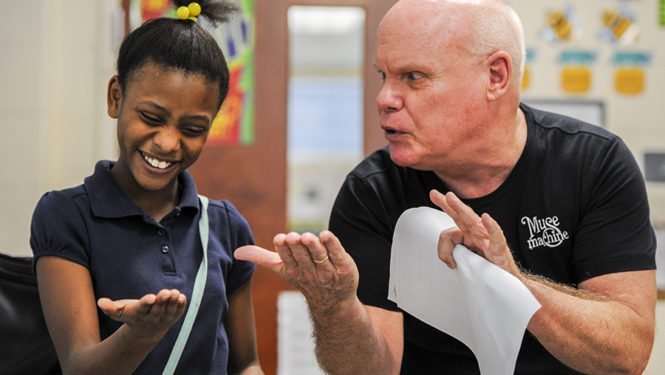Since 2006, our residency artists have teamed with classroom teachers and more than 112,000 students to create curriculum-based art that was shared by over 343,000 community members! Muse Machine brings learning to life through arts-integration residencies in schools across the Greater Miami Valley Region.

Part 1: Create Residency Plan
After the school selects its Muse artist, participating teachers and artist meet to discuss the school’s educational goals, selected Ohio’s Learning Standards, student participation and creative ideas for helping students to experience curricular concepts in new ways and build knowledge through the arts.
All students can benefit from involvement in the artist residency. Often teachers choose a segment of the school population to participate, such as one grade level or several grade levels. Depending on the size of your school, you could involve the entire school population. Residency time frames are determined by the number of participating classrooms and the size of the planned project. Once participating classrooms are identified, a customized schedule is created for the residency by the artist and participating teachers. Your residency dates do not need to be consecutive. You may choose the dates that best serve your teachers and students. The fee for the Preschool and Elementary Program is $450 per day. Typical residency length is five days (shorter visits may also be available).
Residency topics cover the entire curriculum and can dramatically fortify student understanding of challenging subject areas. “When we looked at the strand that we focused on with Muse Machine,” said teacher Kris Brush, “78% of kids across the state passed that particular strand of the test — but 98% of our kids passed… 98%!”
Muse artists have designed hundreds of residency programs. Find examples of past topics below:
-
Language Arts
Alphabet
Author’s Purpose
Capitalization, Punctuation and Spelling
Character Traits
Editing and Revising Strategies
Fact/Opinion
Figurative Language
Inferencing
Letter Sounds
Literary Genre
Main Idea
Mythology
Non-Fiction Text Features
Paragraph Structure
Parts of Speech
Parts of a Story
Phonics
Prefixes/Suffixes
Reading Comprehension Strategies (Questions, Word Detection, Connectors and Literary Illuminations)
Reading Fluency
Roman and Greek Root Words
Sentence Structure
Six Traits of Good Writing
Structure of an Essay
Types of Writing (Informative, Opinion, Narrative)
Vowels/Consonants
-
Math
Addition, Subtraction, Multiplication and Division
Area and Perimeter Associative, Commutative and Distributive Properties
Coordinate Plane
Even and Odd Numbers
Fact Families
Fractions
Geometry
Graphing
Money
Numbers
Number Lines
Order of Operations
Place Value
Plot Sequence
Re-Grouping
Shapes, Lines and Angles
Skip Counting
Telling Time
Two/Three Dimensional Shapes
Patterns
-
Science
Animal Adaptations
Animal Habitats
Biomes
Classifications of Living Things
Elements of Sound
Energy (Sound, Heat, Magnetism, Movement)
Five Animal Groups
Forces of Motion
Landforms
Life Cycles of Humans, Animals and Plants
Living/Non-living
Parts and Systems of the Body
Patterns in Space
Rock Cycle
Scientific Method
Solar System
Solids, Liquids and Gases
Space Exploration
Types of Rock and Minerals
Water Cycle
Weather (Wind Speed, Temperature, Clouds, Effects on Living Things)
-
Social Studies
Adaptations of Native Americans
African American History
American Symbols
American/World Inventors
Cultural Symbols
Diversity
Early Colonial Settlers
Economics
Famous Americans
Famous Ohioans
Map Reading Skills
Mesopotamia
Native Americans
Ohio History
Revolutionary War
Seven Continents
Three Branches of Government
Urban, Suburban and Rural Communities
World Civilizations and Geography
World Cultures
World Oceans
-
Other
Beatitudes (Catholic)
Benedictine Values (Catholic)
Character Education Pillars (Trustworthiness, Respect, Responsibility, Fairness, Caring, Citizenship, The Golden Rule)
Choices and Outcomes
Citizenship
Elements of the PAX Behavior System
Friendship
Gifts from the Holy Spirit (Catholic)
God’s Creations (Catholic)
History of the Montessori Teaching Methods (Montessori)
Mental Health
Physical Health
Positive Behavior Intervention Support
Reconciliation (Catholic)
Respect for Self, Others and Environment
Sacraments (Catholic)
Story of Jericho (Catholic)
Stress Reduction
Teamwork
Part 2: The Residency
During the residency, the artist works with participating teachers and students in their classrooms. The artist introduces the key elements of his or her art form as well as creative ways to use that art form to address the residency’s educational goals. Residencies take many forms, the artists, teachers and students may write original music and songs, choreograph new dances, write and perform original theatre pieces or create works of visual art that bring new meaning and understanding to Ohio’s New Learning Standards.
Part 3: Share New Knowledge
Each residency culminates in a public sharing of what has been created by the artist, teachers and students during the residency. In a culminating activity, students present the original art they have developed during their residency. It is a true celebration of children and the power of arts integration to help find deeper meaning in their studies and connect them to the joy of learning components.
Thank you for your interest in the Muse Machine Preschool & Elementary Program! For more information, click here!
Resident Artist Bios

Beth Wright
Beth Wright is a dancer, choreographer and educator of dance. A former member of the Dayton favorite Rhythm in...

Michael Bashaw
Sculptor/multi-instrumentalist Michael Bashaw is well-known for his performances, sculptures, collaborations and workshops, and has been a featured artist in...

Omopé Carter Daboiku
Omopé Carter Daboiku is a cultural geographer, an award-winning teller of tales and a seasoned stage and voice actor...

Molly Gilbert
A dancer since the age of three, Molly Gilbert is well versed in Ballet, Jazz, Modern, Hip Hop, Acro...

Michael Lippert
Michael Kenwood Lippert is a founding member and resident artist with The Human Race Theatre Company in Dayton, Ohio. As...

Dayton Contemporary Dance Company
Founded in 1968 to create performance opportunities for dancers of color, Dayton Contemporary Dance Company is a culturally diverse...
See our preschool and elementary program in action in the classroom:
The Muse Machine preschool and elementary program is supported in part by the National Endowment for the Arts.
Accessibility
For information about accessibility at teacher programs, out-of-school performances, in-school performances or residencies, click here.

